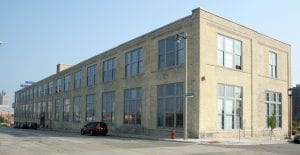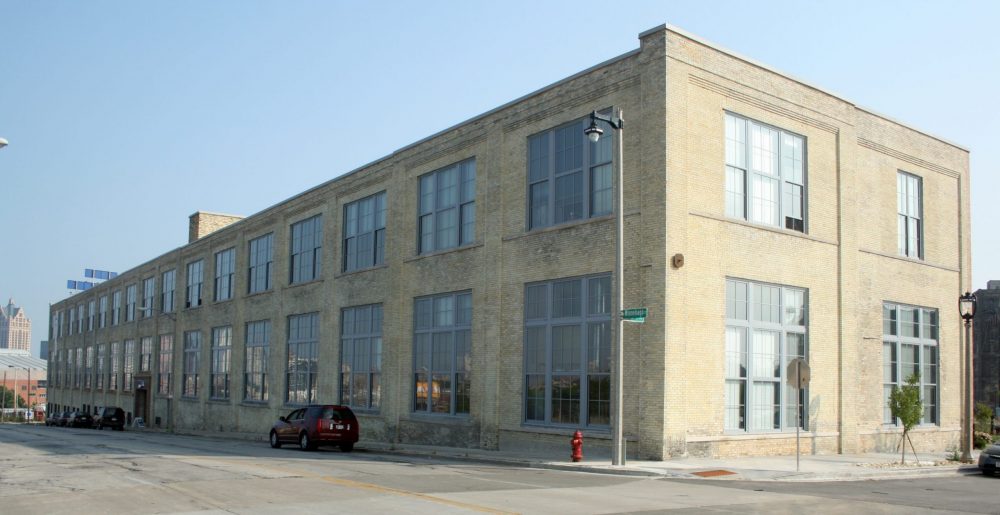
Photo credit: Jeramey Jannene, via flickr.
Affordable housing developments should celebrate the ‘old’ as much as—or perhaps even more than—the ‘new.’ Like most American cities, Milwaukee’s industrial era thrived thanks to thousands of men and women who started from scratch, often taking any job they could get. These individuals created American products often for whatever pay was offered, and with that pay, secured decent, affordable housing within a reasonable distance from the wage earner’s place of work.
How better to pay tribute to the hardworking Americans from our industrial era than to repurpose those old industrial buildings for affordable housing that supports the current generation of hardworking families? With tax credits, loans, grants, and private equity available for affordable housing, developers can feasibly and lucratively redefine our existing built environment.
We’ve been writing about local Milwaukee opportunities, i.e. vacant buildings in jeopardy, and their connection to an issue of national relevance. To wrap up this series on a positive note, this post celebrates an opportunity that is in the process of being realized.
So how can cities creatively marry affordable housing, community quality, historic rehabilitation, vibrant commerce, civic uses, and urban revitalization in one compact neighborhood? Each of us can turn to a handful of national case studies where dedicated citizens have determined just how to make all of these factors coalesce. In Milwaukee, we are watching a long-shuttered part of town undergo exactly this kind of renaissance. The area: a new neighborhood appropriately dubbed “The Brewery,” as its current urban form emerged in the mid- and late-1800s for what would become famously known as the Pabst Brewing Company.
Perhaps Milwaukee’s most critical wave of influence occurred in the late 19th century, when the city’s social character, economic power, and pride-based built environment were largely driven by the beer breweries. Milwaukee’s leading beer barons, Joseph Schlitz, Frederick Miller, Valentine Blatz, and Captain Frederick Pabst constructed iconic buildings, owned real estate in the form of corner bars and beer gardens, employed thousands of Milwaukeeans, built mansions, and most importantly, produced millions of gallons of beer for thirsty Americans. Milwaukee’s beer barons seemingly tackled each of these endeavors with a classic Midwestern work ethic: attention to detail coupled with a commitment to quality. This is clearly evident in the legacy architecture that remains at each brewing site.
Other than Miller Brewing, which remains in production as MillerCoors, the remaining three major breweries have found new lives. Through private development, both the Blatz and Schlitz complexes were the first to undergo redevelopment in the early 1980s. The mothballed Schlitz complex was purchased by The Brewery Works and rebranded as Schlitz Park, where currently over 4,000 individuals are employed by numerous businesses. The Blatz brewery complex, through TIF and historic tax credit incentives, similarly began a new life cycle with the commitment of office tenants for the newly-renovated bottle-washing house. The Blatz brewhouse later followed suit and transformed into the Blatz Condominiums. Both projects, at their respective scales, have repurposed influential facilities and celebrated key facets of the city’s urban fabric.
After numerous unsuccessful attempts by various parties to propose a winning redevelopment plan, the Pabst Brewing Company complex was purchased in 2006 by the Brewery Project LLC with plans to “create a new neighborhood that will rank with other great neighborhoods in Milwaukee.” Behind the Brewery Project LLC was the late Joseph Zilber, a gentleman regarded as a real estate giant and committed philanthropist. Zilber’s private investment has been widely praised for its inclusive, mixed-use, community-minded focus. His visionary private sector leadership quickly earned the adoration of the broader civic realm by tackling the challenges of historic preservation, environmental sustainability, and affordable housing.
The convergence of these efforts is evident in the renovated Pabst Keg Building (Wash House and Cooper Shop), which is now the Blue Ribbon Loft Apartments. The three-story, 140,000 square foot, astylistic, utilitarian, “cream city brick” building was repurposed to provide high-quality, affordable living units for members of the city’s ‘creative class.’ The $15.8 million, 95-unit apartment building was financed in part by Federal Low Income Housing Tax Credits, Federal Rehabilitation Tax Credits, and Wisconsin State Historic Credits.
Today, we have a bright example of affordable housing’s role in building rehabilitation. The kickstarter for the entire Pabst redevelopment stems from the deep financial commitment of one private sector leader, who saw the redevelopment as a legacy project for his family and company. In the case of the Keg Building, the pledged commitment of one private sector partner allowed for a creative development team to garner tax credits, loans, and other support to provide affordable housing and redefine a national landmark.
Influential urban forms evolve through the generations. Over the course of time our urban landscapes change drastically, often driven by strings of local, like-minded leadership. Milwaukee’s rich history of private manufacturing, heavy industry, and socialist government left an indelible mark on our current landscape. This is perhaps most evident when viewing those remnant urban forms of the city’s brewing industry. As we look to the future of our cities, let’s remember the words inscribed on the installation at the Independence Visitor Center in Philadelphia: “go back to the past to build the future.” We can pay tribute to our hardworking ancestors by repurposing the places in which they invested so greatly.
This post was co-authored with Michael Hacker.






Before jumping on the bandwagon of “marry[ing] affordable housing, community quality, historic rehabilitation, vibrant commerce, civic uses, and urban revitalization,” we should think about the neighborhood context and the purpose of LIHTC. By all means, use historic tax credits, NMTC, and other incentives for cool projects like this. But is “provid[ing] high-quality, affordable living units for members of the city’s ‘creative class” really an appropriate use of scarce LIHTC, and in a time of budget cutbacks in HUD programs, can we afford it? Would those dollars be better spent with a focus on providing housing for low income families (and paired with HCV to serve families with the greatest housing needs, i.e. very and extremely low income families)? If the surrounding neighborhood is indeed gentrifying, then planners should use LIHTC as part of historic preservation efforts to preserve or create affordable housing for low income families. But if the housing does not have a substantial deeply targeted component, or the neighborhood is not gentrifying, then wouldn’t it be more appropriate to use the LIHTC to provide affordable housing in other areas where it will most benefit low income families? Its tempting to use LIHTC for all sorts of cool projects (including those designed to generate gentrification) and there is often political clout behind these projects —- but there are real opportunity costs borne by low income families when we do so.